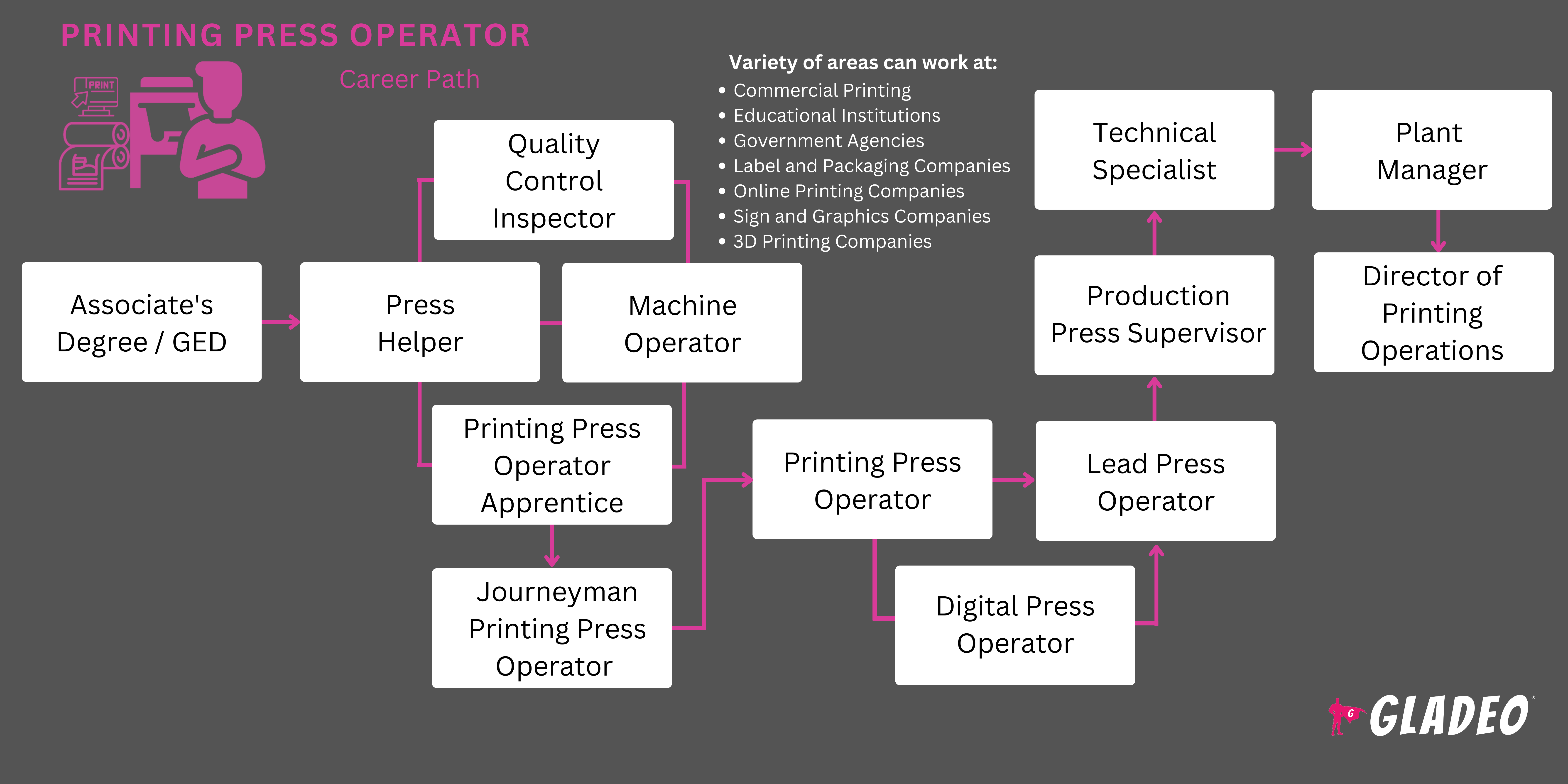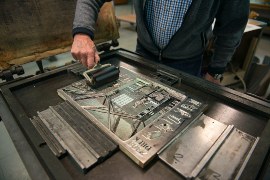Mga spotlight
Digital Press Operator, Flexographic Press Operator, Offset Press Operator, Offset Pressman, Press Operator, Pressman, Printer, Printing Press Operator, Printing Pressman, Web Press Operator, Graphics Equipment Operator, Large Printing Press Machine Setter and Set-Up Operator
Ever think about how newspapers, magazines, and books get made? Probably not. But the process is actually pretty interesting and requires the skill of modern Printing Press Operators!
These behind-the-scenes printing pros are responsible for setting up and operating the versatile, high-tech presses used in the mass production of today’s printed media. This includes offset printing for newspapers, magazines, and books; digital printing for limited-run and on-demand books; and letterpresses for fine art prints and stationery.
Printing Press Operators need a keen eye for detail, excellent mechanical skills, and the ability to troubleshoot and solve problems on the fly. Without their efforts, we wouldn’t have most of the printed materials we use and take for granted!
- Bringing printed materials to life
- Contributing to the production of publications and marketing materials
- Opportunities to work with advanced printing technologies
- Collaborating with creative and technical professionals
Oras ng trabaho
- Printing Press Operators work full-time in print shops, publishing houses, or manufacturing facilities. Schedules may include nights, weekends, and overtime to meet production deadlines.
Mga Karaniwang Tungkulin
- Review job orders. Ensure sufficient ink and paper stock are available to meet print quantity requests
- Collaborate with prepress and post-press departments
- Mix ink and fill ink fountains, as needed
- Prepare presses for production runs. Install printing plates, rollers, and other components
- Verify that workplace humidity and temperature are optimized to prevent common printing issues and ensure a smooth production process
- Load paper stock, adjust feed and tension controls, and input job settings
- Download/scan digital files using production software. Adjust print elements
- Operate auxiliary equipment (for cutting, folding, laminating pages, etc.)
- Review preliminary samples of printed materials (i.e., “proofs”) to confirm proper ink coverage and alignment. Make adjustments, as needed
- Monitor digital, offset, or letterpress machines
- Troubleshoot and fix mechanical issues
- Perform routine preventive maintenance and cleaning
- Supervise staff, as directed
Karagdagang Pananagutan
- Monitor inventory levels and reorder supplies
- Maintain production records. Archive media for future reference
- Manage job scheduling and tracking
- Wear required personal protective equipment and follow safety protocols
- Stay up-to-date on technical manuals and new technologies
Soft Skills
- Analitikal
- Pansin sa detalye
- Kakayahan sa pakikipag-usap
- Pagkamalikhain
- Kagalingan ng kamay
- Good vision and color vision
- Independent
- Kakayahang mekanikal
- Observation
- Organisasyon
- pasensya
- Pagpaplano
- Pagtugon sa suliranin
- Stamina
- Pagtutulungan ng magkakasama
- Pamamahala ng oras
- Visualization
Teknikal na kasanayan
- Knowledge of different printing presses (digital, offset, letterpress, lithographic, flexographic, and gravure machines) and paper cutters
- Desktop publishing programs (Adobe Acrobat, Xerox FreeFlow)
- Pagpaplano ng mapagkukunan ng negosyo
- Pang-industriya na kontrol software
- Pamamahala ng imbentaryo
- Pamamahala ng proyekto
- Computer-to-plate (CTP) systems
- Digital workflows
- Graphics software (Illustrator, Photoshop, InDesign)
- Understanding of prepress and post-press processes
- Ability to troubleshoot and repair mechanical issues. Safe use of cleaning supplies, machine lubricants, and various hand tools
- Familiarity with color theory and ink properties
- Proficiency in using printing software
- Knowledge of paper types and print substrates
- Print shops
- Publishing houses
- Ahensya sa advertising
- Mga kumpanya sa paggawa
- Packaging companies
Printing Press Operators are hired to produce high-quality printed materials by deadlines. This requires precision, keen attention to detail, and sometimes long hours to meet production schedules!
They must master a variety of printing techniques and technologies while ensuring each print run is consistent and free of errors. Precision is crucial since even tiny mistakes can lead to serious cost overages if a run has to be reprinted. However, time management is also critical due to tight turnaround times. As a result, they might have to work nights and weekends to hit their targets and keep customers happy.
Printing press operators need plenty of stamina because they have to stand for extended periods, lift heavy materials, and perform repetitive tasks. Adhering to safety protocols is essential to prevent injuries and ensure a safe working environment.
The printing industry is rapidly embracing digital printing technologies that enable faster turnaround and more customization options. Eco-friendly practices are also a growing trend in the printing world, with companies using recycled materials and water-based inks to minimize environmental impact.
Yet another trend is the automation and computerization of many printing processes, reducing the need for manual intervention, boosting efficiency, and improving overall productivity. The unfortunate side effect is that it decreases the number of Printing Press Operators needed in the future.
Simultaneously, print materials are becoming less popular as consumers increasingly turn to digital resources. Still, there’s a growing market for print-on-demand materials as well as customized high-end packaging that requires advanced printers.
Printing Press Operators may have been fascinated with how things work from an early age. They likely enjoyed working with their hands, building or fixing things, and had an interest in technology and mechanical devices.
- Printing Press Operators need at least a high school diploma or GED
- Some complete vocational training or an associate degree in graphic communications or a related field. Common course subjects include:
- Color theory
- Computer-to-plate (CTP) systems
- Digital workflows
- Adobe Creative Suite (Photoshop, Illustrator, InDesign)
- Graphic na disenyo
- Mechanical maintenance
- Paper and ink properties
- Prepress operations
- Print finishing and binding
- Printing technology
- Safety protocols
- Some employers provide full on-the-job training or apprenticeship opportunities. Relevant apprenticeship titles may include:
- Assistant Press Operator
- Embossing-Press Operator
- Job Printer
- Lithograph Press Operator
- Offset-Press Operator
- Kasama sa mga opsyonal na programa sa sertipikasyon ang:
- Flexographic Technical Association -
1. Implementation Specialist Certification
2. PrePress Operator Certification
3. Press Operator Certification
4. In-Plant Printing and Mailing Association - Certified Graphics Communications Manager
- Printing Press Operators don’t need a four-year degree but can benefit from certificate and associate degree courses related to printing technology, graphic communications, or related fields.
- Look for programs with well-equipped, modernized presses where you can get practical hands-on experience.
- Ideally, programs should have seasoned faculty members and opportunities for internships or cooperative learning with local employers.
- Consider the cost of tuition, discounts, and local scholarship opportunities (in addition to federal aid).
- Take vocational courses in printing technology as soon as possible. Consider getting a certificate or associate degree
- Sign up for classes in graphic design, computer science, and mechanical engineering
- Gain experience through part-time jobs or internships in print shops
- Join groups or online forums related to printing. Study books, online articles, and video tutorials about printing technologies
- Simulan ang paggawa ng iyong resume at idagdag ito habang natututo ka at nakakakuha ng karanasan sa trabaho
- Suriin ang mga pag-post ng trabaho nang maaga upang makita kung ano ang mga karaniwang kinakailangan
- Request to do an informational interview with working Printing Press Operators. Try to speak with operators of different types of equipment. Ask if you can shadow them at work for a day
- Gumawa ng listahan ng iyong mga contact (kabilang ang mga email address o numero ng telepono) na maaaring magsilbing mga sanggunian sa trabaho sa hinaharap
- Build a portfolio of projects to showcase your skills as you can gain practical experience

- Check out job portals such as Indeed, Simply Hired, Glassdoor, and Craigslist
- Look for apprenticeships and printing assistant jobs to get your foot in the door
- Ask working Printing Press Operators for job-seeking tips
- Humingi ng tulong sa career center ng iyong paaralan sa pagkonekta sa mga recruiter at job fair
- Magtanong nang maaga sa mga potensyal na sanggunian upang makita kung irerekomenda ka nila o magsulat ng mga liham ng sanggunian
- Check out online Printing Press Operator resume templates and review potential job interview questions
- Brush up on terminology and news about the field before heading into interviews. Be ready to discuss your insights about trends and advancements
- Know how to dress for a job interview!
- Be diligent about catching errors, doing preventative maintenance, and meeting production deadlines
- Ask your supervisor how you can boost your knowledge and skills to serve the company better
- Study manufacturer and software guides. Be the go-to expert on the programs (such as those in Adobe Creative Suite) and printing machines you use
- Knock out specialized certifications related to new methods and technologies. The Flexographic Technical Association offers certifications like PrePress Operator Certification and Press
Operator Certification which can be handy! - Demonstrate that you can work independently and effectively supervise teams
- Train new workers patiently and thoroughly
- Always wear appropriate personal protective equipment to avoid mishaps and hazards
- Write “how-to” articles to establish yourself as an industry leader
- Branch out into different types of printing methods to expand your horizons
- Consider relocating if needed to advance your career! The states with the highest concentration of relevant jobs are Wisconsin, Nebraska, Minnesota, Kansas, and Illinois
Mga website
- Association for PRINT Technologies
- Flexographic Technical Association
- International Brotherhood of Teamsters
- International Digital Enterprise Alliance (IDEAlliance)
- Print and Graphic Communications Association
- PRINTING United Alliance
Mga libro
- Pocket Pal: A Graphic Arts Production Handbook, by Frank Romano
- Print Production with Adobe Creative Cloud, by Claudia McCue
- The Print Handbook, by The Print Handbook Co.
Printing Press Operators are vital in the printing industry, but job growth in this field may be limited as consumers switch from printed to digital materials. It’s still a viable career option, but if you’re curious about other occupations, check out our list below!
- Bindery Worker
- Cutting, Punching, and Press Machine Operator
- Digital Press Operator
- Grapikong taga-disenyo
- Milling and Planing Machine Operator
- Multiple Machine Tool Setter
- Packaging Technician
- Paper Goods Machine Setter
- Photographic Process Worker
- Prepress Technician
- Production Planner
- Quality Control Inspector
Newsfeed

Mga Tampok na Trabaho

Mga Online na Kurso at Tool







